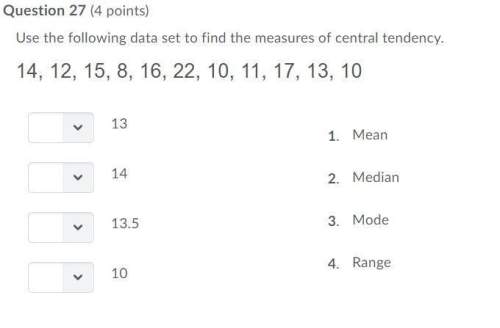
Mathematics, 03.07.2019 05:10 anthonyhaywood
Asample of 65 observations is selected from one population with a population standard deviation of 0.75. the sample mean is 2.67. a sample of 50 observations is selected from a second population with a population standard deviation of 0.66. the sample mean is 2.59. conduct the following test of hypothesis using the .08 significance level. here the null hypothesis and alternative hypothesis are h0: µ1 is less than or equal to µ2ha: µ1is greater than µ2a. is this a one-tailed or a two-tailed test? b. state the decision rule. c. compute the value of the test statistic. d. what is your decision regarding h0? e. what is the p-value?

Answers: 2


Another question on Mathematics


Mathematics, 21.06.2019 20:20
Recall that the owner of a local health food store recently started a new ad campaign to attract more business and wants to know if average daily sales have increased. historically average daily sales were approximately $2,700. the upper bound of the 95% range of likely sample means for this one-sided test is approximately $2,843.44. if the owner took a random sample of forty-five days and found that daily average sales were now $2,984, what can she conclude at the 95% confidence level?
Answers: 1

Mathematics, 21.06.2019 21:50
Determine the common ratio and find the next three terms of the geometric sequence. 10, 2, 0.4, a. 0.2; -0.4, -2, -10 c. 0.02; 0.08, 0.016, 0.0032 b. 0.02; -0.4, -2, -10 d. 0.2; 0.08, 0.016, 0.0032 select the best answer from the choices provided a b c d
Answers: 1

Mathematics, 21.06.2019 23:00
Each of the following data sets has a mean of x = 10. (i) 8 9 10 11 12 (ii) 7 9 10 11 13 (iii) 7 8 10 12 13 (a) without doing any computations, order the data sets according to increasing value of standard deviations. (i), (iii), (ii) (ii), (i), (iii) (iii), (i), (ii) (iii), (ii), (i) (i), (ii), (iii) (ii), (iii), (i) (b) why do you expect the difference in standard deviations between data sets (i) and (ii) to be greater than the difference in standard deviations between data sets (ii) and (iii)? hint: consider how much the data in the respective sets differ from the mean. the data change between data sets (i) and (ii) increased the squared difference îł(x - x)2 by more than data sets (ii) and (iii). the data change between data sets (ii) and (iii) increased the squared difference îł(x - x)2 by more than data sets (i) and (ii). the data change between data sets (i) and (ii) decreased the squared difference îł(x - x)2 by more than data sets (ii) and (iii). none of the above
Answers: 2
You know the right answer?
Asample of 65 observations is selected from one population with a population standard deviation of 0...
Questions




History, 03.09.2020 15:01

Mathematics, 03.09.2020 15:01

Biology, 03.09.2020 15:01



Chemistry, 03.09.2020 15:01

Mathematics, 03.09.2020 15:01


English, 03.09.2020 15:01

Mathematics, 03.09.2020 15:01


Social Studies, 03.09.2020 15:01

Mathematics, 03.09.2020 15:01



Computers and Technology, 03.09.2020 15:01




